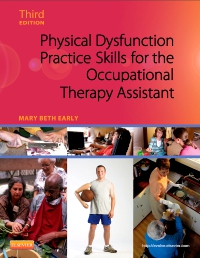
Physical Dysfunction Practice Skills for the Occupational Therapy Assistant - Elsevier eBook on VitalSource, 3rd Edition
Elsevier eBook on VitalSource

Covering the scope, theory, and approaches to the practice of occupational therapy, this market-leading text prepares students to care for adults who have physical disabilities. It takes a client-centered approach, following the latest OT Practice framework as it helps students to understand the role of the occupational therapy assistant and to develop clinical reasoning skills. New to this edition is coverage of polytrauma, advances in prosthetics and assistive technologies, and assessment and interventions of traumatic brain injury problems related to cognitive and visual perception.
Newer Edition Available
Early’s Physical Dysfunction Practice Skills for the Occupational Therapy Assistant - Elsevier eBook on VitalSource
-
- NEW content on the latest advances in OT assessment and intervention includes prosthetics and assistive technologies, and updated assessment and interventions of TBI (traumatic brain injury) problems related to cognitive and visual perception.
- Case studies offer snapshots of real-life situations and solutions, with many threaded throughout an entire chapter.
- A client-centered approach allows the OTA to include the client when making decisions about planning and treatment, using the terminology set forth by the 2008 Occupational Therapy Practice Framework.
- Evidence-based content includes clinical trials and outcome studies, especially those relating to intervention.
- Key terms, chapter outlines, and chapter objectives introduce the essential information in each chapter.
- Reading guide questions and summaries in each chapter make it easier for students to measure their comprehension of the material.
- Information on prevention is incorporated throughout the book, especially in the Habits on Health and Wellness chapter.
- Cultural diversity/sensitivity information helps in providing care in a manner sensitive to the beliefs and customs of diverse cultures.
- Student resources on an Evolve companion website include review questions, forms for practice, crossword puzzles, and other learning activities.
- Educator Resources on Evolve include an instructor's resource manual, test bank questions, an image collection, and PowerPoint® lecture slides.
-
- New content on the latest advances in OT assessment and intervention includes prosthetics and assistive technologies, and updated assessment and interventions of TBI (traumatic brain injury) problems related to cognitive and visual perception.
-
Part I: Foundations
1. Occupational Therapy and Physical Disabilities
2. The Disability Experience and the Therapeutic Process
3. Infection Control and Safety Issues in the Clinic
Part II: Process
4. Occupational Therapy Process: Evaluation and Intervention in Physical Dysfunction
5. Documentation of Occupational Therapy Services
Part III: Assessment
6. Assessment of Motor Control and Functional Movement
7. Assessment of Joint Range of Motion
8. Assessment of Muscle Strength
9. Evaluation and Observation of Sensation, Perception and Cognition
Part IV: Intervention Principles
10. Teaching and Learning in Motor Performance
11. Habits of Health and Wellness
12. Occupations, Purposeful Activities, and Preparatory Activities
Part V: Performance in Areas of Occupation
13. Activities of Daily Living
14. Assistive Technology
15. Moving in the Environment
16. Sexuality: An Activity of Daily Living
17. Work
18. Promoting Engagement in Leisure and Social Participation
Part VI: Interventions for Performance Skills and Client Factors
19. The Older Adult
20. Hand Splinting
21. Neurotherapeutic Approaches to Treatment
22. Interventions for Visual and Other Sensory Dysfunction
23. Interventions for Disturbances in Cognition and Perception
Part VII: Clinical Applications
24. Cerebrovascular Accident
25. Traumatic Brain Injury
26. Degenerative Diseases of the Central Nervous System
27. Spinal Cord Injury
28. Neurogenic and Myopathic Dysfunction
29. Arthritic Diseases
30. Acute Hand Injuries
31. Hip Fractures and Lower Extremity Joint Replacement
32. Burns
33. Amputation and Prosthetics
34. Cardiac Dysfunction and Chronic Obstructive Pulmonary Disease
35. Oncology
36. HIV Infection and AIDS


 as described in our
as described in our 